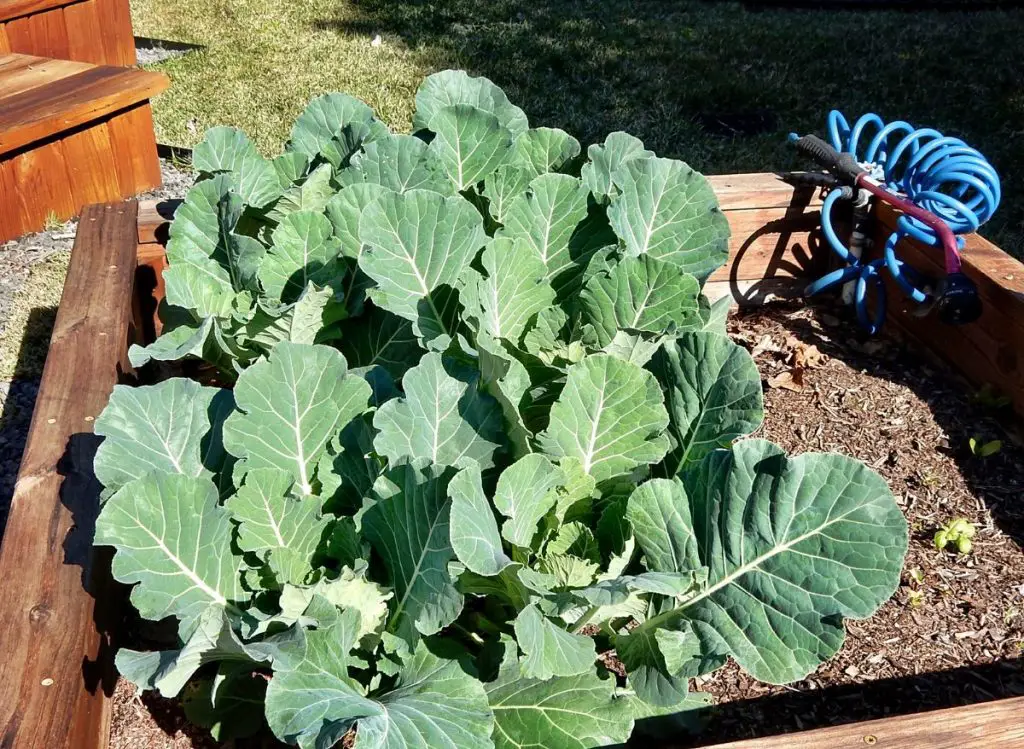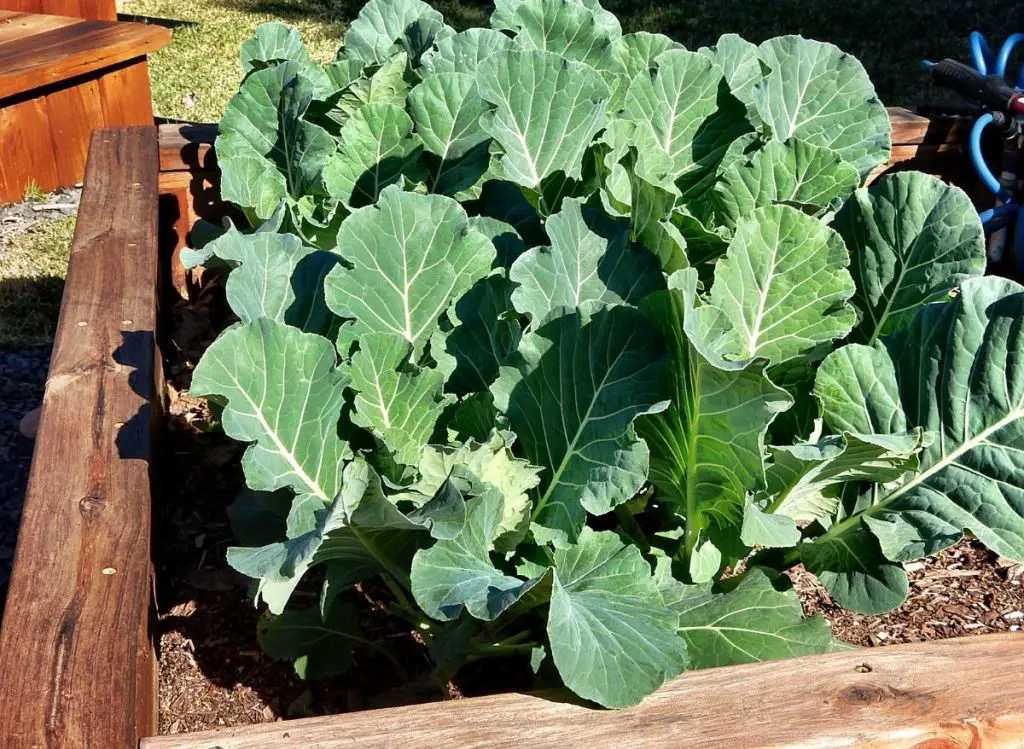
Collard greens are cool-season leafy greens that can be grown twice each year in Georgia – once in the spring and again in the fall. As long as collards have about 75 days of cool weather, they can go from seed time to harvest time.
So, when to plant collards in Georgia? Collards are leafy greens that hate hot weather, so if you want to plant collards in Georgia, you have to get the seeds in the ground no later than mid-March for a spring harvest and no later than mid-August for a fall harvest.
Read on to find out everything you need to know about growing collard in Georgia.
If you are planning to add collard green and want to improve your chances of success, I wrote a whole article about the 15 Companion Plants For Swiss Chard, including plants to avoid. Check it out!
What You Need To Know Before Planting Collards In Georgia
Collards are cool-season leafy vegetable members of the cabbage family that do better in warm and cold temperatures than cabbage (Source: University of Georgia)
1- Spring Planting
Climates vary greatly in Georgia – from coastal south Georgia to mountainous north Georgia – so exact planting dates will differ. Collard seeds can be sown in your garden two weeks before the last predicted frost date in spring in your part of Georgia.
The seeds will germinate in soil that is 10-30F degrees in 5-10 days. A late spring cold snap will not harm the seeds or seedlings.
2- Bolting
Collards will develop a flowering seeds stalk as soon as the weather gets too warm for the plant’s liking. This is known as bolting.
Once the plant has bolted it will stop growing, and the leaves will begin to degrade. If you harvest the leaves at the first sign of bolting, they will still be edible but may have a slightly bitter flavor.
If the plant is past eating and it’s early summer, pull the bolted plant up and place it in the compost pile. Add organic matter to the soil and plant warm-season crops, like cucumbers.
If any collard plants remain in the garden at the end of fall, allow them to remain in the garden soil throughout the winter. The plants will protect the soil from erosion and compaction.
3- Fall Harvest
A fall harvest of fresh collard greens is great. When most other garden plants have finished producing for the season, you can look forward to fresh greens in October, November, and maybe in December, depending on your specific Georgia location.
Count back 75 days from the first predicted frost date in your area. Plant collard seeds around that date. A light frost will not hurt collard greens; it actually makes the greens develop a sweeter flavor.
4- Winter Cover Crop
Collards are an important garden crop, even if you don’t like to eat them. When planted in late summer and allowed to remain in the garden throughout the winter, the plants will improve and protect the soil.
The plants will protect the soil from being eroded by winter winds and rains. They also protect the soil from being compacted by heavy snowfall. As soon as the soil is workable in early spring, the decaying collard plants can be turned under the soil, where they will finish decomposing.
The decomposing organic material will increase soil fertility, improve the structure, and attract earthworms to your garden.
When To Plant Collards In Georgia?
The best time to plant collards in Georgia is usually in the fall for winter harvest, but you can also grow your collards in late winter for early summer and spring harvest.
If you are aiming for the earliest spring production, you should begin with store-bought transplants with good green color, short and compact, and free of pests.
You should sow your collards’ seed in mid-July for a fall crop.
How Do You Plant Collard Greens In Georgia?
- Select a planting location that is in full sun. Turn the soil, add 2-4 inches of compost or well-aged animal manure and lightly turn it under. Rake the top of the amended soil smoothly.
- Create shallow rows that are 1/2-inch deep and 2 feet apart. Collards grow large leaves and need plenty of space to spread out and allow air to circulate between plants.
- Plant seeds 6-inches apart in the rows and cover with 1/2 inch of soil.
- Water gently so seeds will not be disturbed.
- Keep soil moist.
- When the seedlings are 3-inches tall thin them out to 2 feet apart. The plucked-up seedlings are edible and make a flavorful addition to a salad or stir fry.
- Collard seeds will germinate in 5-10 days and will take 75 days to reach maturity.
- It is recommended to use a broad garden fertilizer of about 10-10-10, at a rate of 11/2 pounds (about 2.5 kg) per 100 square feet of garden.

Watering And Maintenance Of Collards In Georgia
Collards need high-nitrogen plant food that will promote large leaf growth. Well-aged animal manure, grass clippings, coffee grounds, fish emulsion, and blood meal are a few organic plant foods that will increase the nitrogen level in the soil.
Keep soil moist at all times but not soggy. Water-soluble plant food helps to keep the plant fed and watered in one easy step. Compost or manure tea makes excellent water-soluble plant food for collards and will increase the nitrogen level in the soil while hydrating the plants.
Mulch around the plants to help the soil retain moisture, prevent weed growth, and help keep the soil cool in the late spring so the plants will continue growing longer before bolting. Use rough mulch, like tree bark, to keep crawling and creeping pests away from the plants.
How To Harvest Collards?
Collard leaves can be harvested at any stage of growth. The smaller and younger the leaves, the more tender and sweet they will be.
Tips On How To Harvest Collards:
- Cut off the outer leaves first and feed plants immediately after harvesting to encourage new leaf growth.
- Continue to harvest the outer leaves until the plant bolts, or you decide to harvest the entire plant.
- To harvest the entire plant, use a sharp knife and cut the stalk 4 inches above the soil level.
- Leave the stalk in the soil, and new leaves will begin to emerge and can be harvested individually.
Organic Pest Control
Collards are subject to pest attacks just like any other garden plant. To keep the green leaves pest-free without chemicals, create a DIY organic pest control and spray the leaves at the first sign of a pest problem.
Here’s how to make DIY organic pest control for collards:
- Put 2 cups of any type of hot pepper and 2 cups of water in the blender.
- Mix until smooth.
- Put liquid in a small pan and simmer for about 5 minutes.
- Strain the mixture, and pour it into a spray bottle.
- Spray on plants as needed.
- After making your easy DIY organic pest control spray and use it to protect your collards.
Collards Health Benefits
Collards are rich in vitamins A, C, and K and are loaded with potassium, calcium, antioxidants, and fiber (Source: healthline.com)
The leafy greens will help improve digestive health, lower bad cholesterol, help build strong bones, improve calcium absorption, boost your immune system, and help regulate blood sugar levels.
Collards’ health benefits and nutritional value earn them a spot in your garden each year.
How To Use Collard Greens?
The large green leaves can be used the same way you enjoy spinach or cabbage leaves. They can be eaten raw or cooked.
- Use the large, sturdy leaves as a wrap for other foods.
- Shred the leaves and add them to casseroles, stews, or soups to bulk them up.
- Use raw shredded collard leaves in slaw mixes and green salads.
- You can make a tasty pesto with collards.
The most popular cooking method in Georgia for collards is simply to cook a large pot of leaves. The leaves cook down to a fraction of their original size, so you must start with a large pot. Here’s how
- Remove the stems and just use the tender leaves.
- Fill the pot about halfway with water, boil the water and add whole collard leaves that have been washed. The leaves can be roughly chopped to reduce cooking time.
- Add salt, pepper, red pepper flakes, garlic, onion, fatback, bacon grease, ham chunks, or any other of your favorite seasonings to the water while the greens cook.
Best Varieties Of Collards To Grow In Georgia
Georgia collards and vates collards are the two most suitable varieties that grow exceptionally well in Georgia, according to the University of Georgia.
- Georgia collards are large collard plants that taste like cabbage. It can grow up to 36″ (91.44 cm) tall. In addition, Georgia collards take about 75 days to mature, are tolerant to heat and cold, and offer good yields.
- Vates collards are slow-bolting collards that come with large blue-green leaves on 32″ (81.28 cm) tall plants. Moreover, Vates collards are known to be high-quality frost-resistant greens suited to southern areas, including Georgia. More importantly, Vates collards also take about 75 days to mature and offer good yields.
What to read next:

